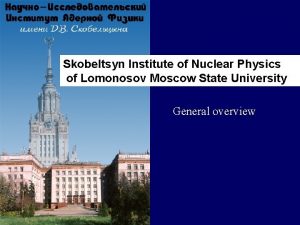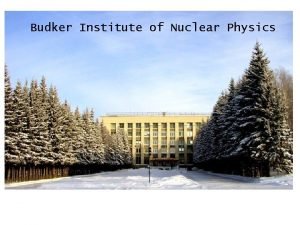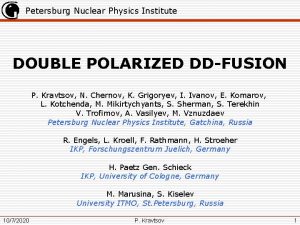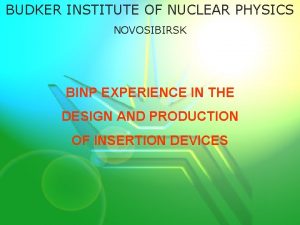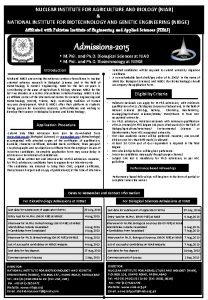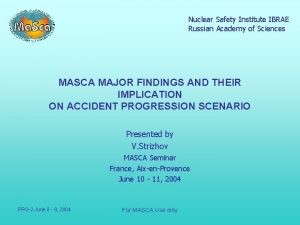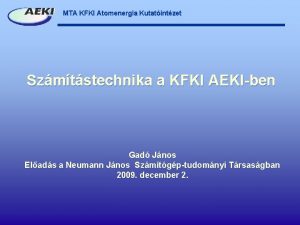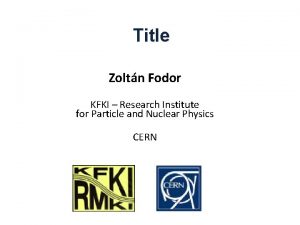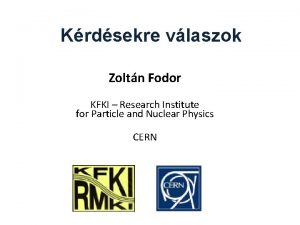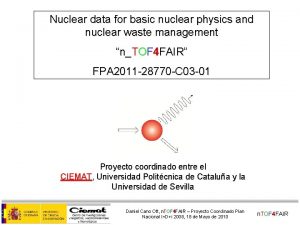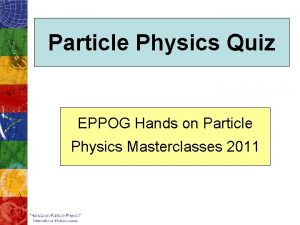KFKI RESEARCH INSTITUTE FOR PARTICLE AND NUCLEAR PHYSICS








- Slides: 8

KFKI RESEARCH INSTITUTE FOR PARTICLE AND NUCLEAR PHYSICS OF THE HUNGARIAN ACADEMY OF SCIENCES Address: Konkoly Thege Miklós út 29 -33, H-1121 Budapest, Hungary Nu. PECC Meeting, 7 -8 October, 2011, Budapest, Hungary

Prof. Károly Simonyi 1916 - 2001 Builder of the first particle accelerator in Hungary initiator of nuclear phyics research in KFKI (father of Charles Simonyi)

MISSION OF KFKI RMKI is the Hungarian basic institution of three so-called „high-tech physics” fields using high technology and studied in large multilateral international collaborations. These fields are: • High-energy nuclear and particle physics, heavy ion physics • Energetic oriented fusion research • Cosmic physics and space technics In addition KFKI RMKI is also acting as the co-ordinator of the Hungarian research activities in these fields.

RESEARCH ACTIVITIES High Energy and Heavy Ion Physics major experiments with KFKI RMKI participation LHC ALICE and CMS, NA 61 (CERN), RHIC PHENIX (Brookhaven), the LHC Grid project; engineering: fast data links Nuclear Solid State. Physics fundamental research on condensed-matter systems of potential technological application utilising nuclear methods, methodological development of nuclear techniques for solidstate physics and materials sciences Theoretical Physics high energy heavy ion colisions, theory of gravitation, field theory and particle physics Plasma Physics tokamak edge plasma phyics, plasma diagnostics even in the ITER project, (host of HAS-EURATOM Association), laser physics, atom optics Space Physics solar wind interactions with planets and solar system bodies, the physics of the geospace, spacecraft instrumentation for several international space missions (Rosetta, Cassini, etc) Biophysics computational neuroscience, study of complex systems elemental analyis of biological and environmental samples, non-destructive analysis of art and arcaeological objects Computer Centre Internal and Campus network, LHC Grid node

MAIN STATISTICAL DATA (2010) Staff: ~ 214 (including ~ 125 research fellows) Annual budget: 1554 million HUF (5. 65 million EUR) core funding from HAS: 1036 MHUF National Research Fund: 98 MHUF EURATOM: 167 MHUF ESA PECS: 86 MHUF Nat. Off. Res. Tech. 86 MHUF contracts (tenders): 71 MHUF Number of publications in SCI journals: ~ 600 Staff members teaching in universities: ~ 40

THE ACCELERATOR COMPLEX the 500 ke. V Heavy Ion Cascade The 5 MV Van de Graaff the proton microbeam

THE MOLECULAR BEAM EPITAXY MACHINE

THE GINA POLARIZED NEUTRON REFLECTOMETER
 Skobeltsyn institute of nuclear physics
Skobeltsyn institute of nuclear physics Budker institute of nuclear physics
Budker institute of nuclear physics Petersburg nuclear physics institute
Petersburg nuclear physics institute Budker
Budker Lesson 15 nuclear quest nuclear reactions
Lesson 15 nuclear quest nuclear reactions Fisión nuclear vs fision nuclear
Fisión nuclear vs fision nuclear Nuclear institute for agriculture and biology
Nuclear institute for agriculture and biology Quantum and nuclear physics
Quantum and nuclear physics Nuclear safety institute of the russian academy of sciences
Nuclear safety institute of the russian academy of sciences
